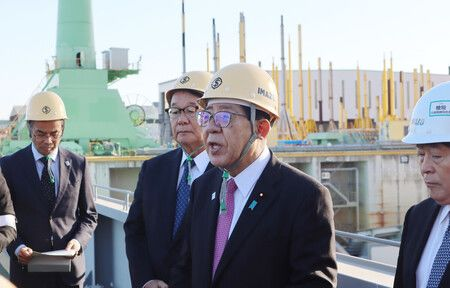Japanese transport minister Yasushi Kaneko, stated on Saturday (November 22) that revitalizing the nation’s shipbuilding industry through measures such as expanding shipyard capacity holds significant strategic importance.

After inspecting the flagship facility of industry leader Imabari Shipbuilding in Marugame City, western Kagawa Prefecture, Yasushi Kaneko emphasized: “Unless shipyards expand their facilities, Japan’s shipbuilding industry will continue to lag behind China and South Korea.”
The Japanese government announced in its comprehensive economic plan adopted on November 21 that it will formulate a roadmap for revitalizing the shipbuilding industry by the end of 2025, with plans to invest approximately 1 trillion yen in public and private funds. The goal is to double Japan’s annual ship production from the current level of about 9.1 million gross tons by 2035.
Yasushi Kaneko stated that to significantly increase production capacity, investment must be made across the entire shipbuilding process. He also expressed his desire to actively leverage digital transformation technologies to address the labor shortage in the shipbuilding industry.
It is reported that the Japanese government first announced its goal to double shipbuilding capacity by 2035 this September, aiming to increase its annual shipbuilding capacity to 18 million gross tons by 2035—a doubling from 2024 levels. At the time, the specific investment figures and the scale of government and corporate investments under this plan were not disclosed.
According to reports at that time, if the Japanese government’s proposed targets were achieved, Japan’s share of the global shipbuilding market would rise from the current 13% to around 20%.
Currently, the global shipbuilding industry is dominated by China and South Korea. According to statistics from Clarksons Research, a UK-based shipbuilding and shipping industry analysis firm, in terms of global new ship orders in 2024, China ranked first with 4.64 million CGT (compensated gross tons, 1,711 vessels), accounting for 70% of the market share; South Korea ranked second with 10.98 million CGT (250 vessels), accounting for 17% of the market share.
Japan’s shipbuilding industry once held approximately 40% of the global market share in the 1990s, but its share gradually declined with the rise of China and South Korea’s shipbuilding sectors. By 2024, Japan’s actual shipbuilding capacity stood at only 9.08 million gross tons, accounting for about 13% of global capacity, marking a significant decline in the industry’s influence.
Cost issues have become the core bottleneck hindering Japan’s shipbuilding industry from achieving scale expansion and regaining competitiveness. According to analysis by Japan’s Ministry of Land, Infrastructure, Transport and Tourism, taking bulk carriers—a primary ship type—as an example, China’s construction costs amount to only 80% of Japan’s. The Nikkei Asian Review notes: “Measures such as reducing material costs through joint procurement and controlling manufacturing expenses by enhancing production efficiency are becoming increasingly crucial.”


